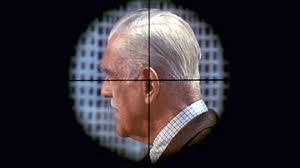
Targets (Movie Review)
In the latter half of the 1960s, Boris Karloff owed legendary exploitation film producer Roger Corman two days of work. Karloff was 81 years old, only had one functional lung and, when the cameras weren’t rolling, was mostly confined to a wheelchair, an oxygen mask strapped to his face. Even with his best days behind him, he was still Boris Karloff, the man behind the makeup of some of the greatest movie monsters to ever grace the screen.
Corman did some of the genius low-budget film producer math he was so good at and figured he could use about 20 minutes of footage from “The Terror,” an earlier Corman movie starring Karloff and a young Jack Nicholson, shoot 20 minutes of new material with Karloff and round the film out with 40 minutes of additional footage. He tapped an up-and-coming director named Peter Bogdanovich and told him that if he could work within these restraints and come in under budget he could make any film he liked. Bogdanovich looked to the headlines for his inspiration and came up with a story based primarily on two sniper attacks from recent years: the 1966 Highway 101 sniper attack in which a teenager killed three people in southern California by firing into oncoming traffic and Charles Whitman’s sniper attack at the University of Texas, which left 16 people dead and 32 people wounded.
Bogdanovich’s resulting film debut, “Targets,” hinges upon a key contrast and follows two separate stories which converge at the climax. Karloff represents the movie monsters of the past: gothic, only vaguely threatening and more than a few steps removed from reality. In the role of fading horror movie icon Byron Orlok, Karloff is essentially playing himself. Orlok is eager to retire because he feels that the characters he plays and the movies he makes are no longer relevant. A young director (played by Bogdanovich) tries to talk him into making one more movie but Orlok refuses, agreeing only to make one final promotional appearance to promote his newest film (cue Corman’s leftover “The Terror” footage). The other storyline is teased early in the film, as we watch Orlok and his crew discussing the future (or lack thereof) of his career. We suddenly see Orlok through a set of crosshairs, which belong to a rifle being tested out in a gun shop by a freshly-scrubbed All-American type named Bobby Thompson. Bobby buys the rifle and takes it out to his car and puts it in the trunk, next to a burgeoning arsenal of other assorted rifles and handguns. Gulp.
The first part of Bobby’s story is a slice of 1960’s mundanity. He and his pretty little wife regularly have family dinners with his parents. In one scene, he goes out shooting tin cans with his dad and from the number of hits both of them make it’s pretty clear that this is a long-kept father-son activity. We can assume that Bobby aiming the gun at his dad while his back is turned setting up the cans is a newer behavior. For the most part, Bobby’s a cypher. He doesn’t seem to have a job or many personal connections outside his family, but there are a few clues that he has recently returned from Viet Nam. Unlike the movie monsters Orlok plays there’s no clear motive behind Bobby’s madness. Something just snaps inside his head and he decides to kill his family first and then as many random strangers as possible.
Bobby’s shooting rampage begins atop a gas tank on the side of the highway. He neatly lays out his weapons, eats a Twinkie and then takes aim at the drivers speeding along the road. When he has caused enough mayhem on the highway, he picks up his things and makes his way to the drive-in, where he sets up just behind the screen to shoot at the audience who are awaiting the live appearance of Byron Orlok. The shooting spree is shot in a way that reflects Bobby’s demeanor – straight-forward and emotionless. There’s no pounding music, no escalating suspense, just a guy going about his grisly business like it was his everyday job.
“Targets” is often cited as a turning point in the grand history of horror movies, neatly dividing the creaky fright flicks of Karloff’s heyday from the more realistic direction the films would take in the 1970s and beyond. Just a few years after the debut of “Targets” films like “Night of the Living Dead”, “Halloween” and “The Texas Chainsaw Massacre” would forever change what most people thought of as a horror film.
While “Targets” was certainly prescient in seeing that horror would take a turn for the realistic (or at least grisly), and it launched the career of a director who would go on to be considered one of the top directors of the 1970s (Bogdanovich’s next film “The Last Picture Show” would be nominated for eight Academy Awards and win two), it’s still a shaky and uneven film. For one, the two storylines don’t always work together. The theme of movie horror vs real horror is plain to see but it’s never really clear what Bogdanovich is trying to say about the concept other than to point out that they’re different.
At the end when the storylines converge it feels more like it’s in service of a grand thematic scheme rather than for any storytelling reason. The Orlok scenes are saved only by Boris Karloff being arresting and interesting to watch, even though there’s not much going on there. The sniper scenes are naturally a bit more engaging due to the subject matter, but even then Bogdanovich sometimes muddies his point. Maybe this is a product of the film being ahead of its time but some of the kills are so stagey and bloodless (think one shot and the victim collapses, instantly dead like something out of an old cowboy movie) that it undercuts the theme of the movie. Flaws aside, “Targets” is worthy as a key turning point in horror history, as a look at the somewhat disreputable roots of a director who would become a critics’ darling and as a fitting coda to the career of one of the most iconic horror actors of all time.

